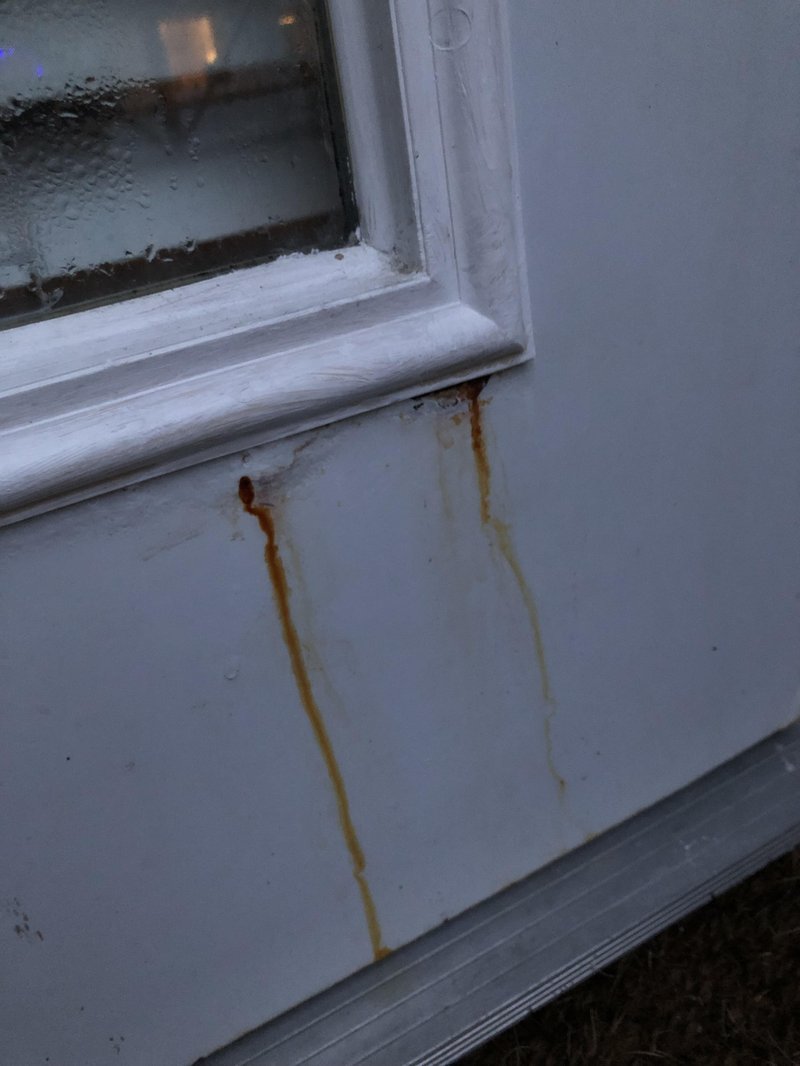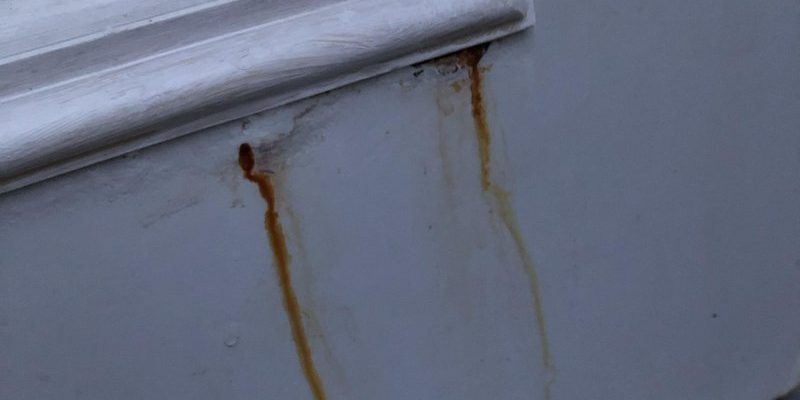
Here’s the thing: exterior door thresholds, like those from brands such as Pemko, Schlage, or National Guard, are stuck right in the line of fire. They get hit with rain, tracked-in mud, snow, road salt, and whatever else your shoes drag in. And depending on the materials, their built-in defenses against rust only last so long. Let me explain why rust loves hanging out on these spots and what you can actually do about it.
What Causes Rust on an Exterior Door Threshold?
To really understand what’s happening, it helps to think like rust. Rust isn’t picky; it just needs three things: iron, water, and oxygen. If your door threshold has steel or iron parts (even if they’re hidden under a thin coating), it’s basically inviting rust to show up any time moisture lingers.
Here’s how it usually plays out: Moist air or water sneaks into the tiny scratches or nicks in your door threshold’s finish. Maybe it’s from a rainy day, someone power washing the porch, or just morning dew that never quite dries. As soon as water gets cozy with the metal, it starts a chemical reaction called oxidation. That’s the science-y way of saying the metal is breaking down and turning orange-brown.
Not all thresholds rust at the same rate, though. Some have aluminum or brass coatings, some are solid wood with a metal edge, and others are just plain steel. These differences mean some thresholds stay rust-free for years, while others start showing rust spots after their first winter.
Common Places Where Rust Spots Show Up First
Rust doesn’t attack evenly—it likes to hang out in the weakest spots. You’ll often see rust gathering in little clusters near seams, edges, screw holes, or anywhere water can sneak in and stay put.
Think about:
- The area right under the door sweep or weatherstripping, where water sometimes pools
- Cracks where the threshold meets the door jamb
- Any chips or scratches where the metal’s protective finish is damaged
Honestly, a lot of people don’t even notice these spots until the rust starts growing larger or flakes off, leaving rough patches. If you’ve got a storm door or a lot of foot traffic, those factors can speed things up, too.
Why Some Brands and Materials Rust Faster Than Others
You might be wondering, “But I spent good money on a Pemko or Schlage threshold—why is it rusting?” Even the best brands can’t always outsmart nature, but the material makes a huge difference.
Here’s a quick rundown:
- Aluminum thresholds: These resist rust, but not all “aluminum” thresholds are pure. Some have steel screws or hidden parts that can rust.
- Steel thresholds: Tough but quick to rust if the paint or plating gets scratched.
- Brass or bronze thresholds: These look fancy and resist rust but can still tarnish or corrode in salty or wet conditions.
If your threshold has a removable cap or rubber gasket, check underneath. Sometimes those hide rusty spots, especially if water gets trapped underneath and can’t dry out.
How Poor Installation or Door Alignment Triggers Rust
Let’s say your door threshold wasn’t perfectly installed. Maybe it tilts just a hair, creating a tiny “pool” for rain to gather. Or maybe the weatherstripping doesn’t quite seal, so water seeps in every time it rains. Over time, even small leaks or gaps act like a welcome sign for rust.
Some installers use standard steel screws, even on thresholds that are supposed to be rustproof. If you see rusty screw heads, that’s usually the culprit. Water travels along the threads and causes tiny rust blooms, which can eventually spread to the rest of the threshold.
A misaligned door can also put extra stress on certain parts of your threshold, causing the finish to wear down faster. Once the protective layer is gone, all it takes is a week or two of damp weather for rust to appear.
The Role of Weather, Climate, and Maintenance
If you live near the coast or in a rainy climate, your exterior door threshold gets more of a workout. Salt in the air (even miles from the ocean) can eat away at finishes much faster, so rust shows up sooner and spreads faster.
Winter brings its own set of headaches:
- Snow and ice melting right against the threshold
- Road salt and de-icer pellets tracked in on shoes
- Repeated freeze-thaw cycles that stress seams and finishes
Regular cleaning and quick touch-ups make a big difference. If you let dirt, sand, and road grime build up, you’re basically covering your threshold with a scratchy, moisture-loving layer that helps rust get started.
How to Stop Rust Spots from Getting Worse
Once you see a rust spot, don’t ignore it. Like a pothole, it always gets worse if you wait. The fix is actually easier than you might think, especially if you catch it early.
Here’s what usually works:
- Use fine sandpaper or a wire brush to gently remove the rust. Be patient—don’t gouge the metal.
- Clean the area with soapy water, then dry it completely.
- Apply a rust-inhibitor primer, then touch up with outdoor-grade paint or metal sealant.
- For deeper pits, you might need to fill in the area with epoxy before priming and painting.
For thresholds with hidden screws or parts, check if you can remove the cap or access the underside. If you spot rust down there, treat it the same way. And if your screws are already rusted, swap them for stainless steel or coated ones to avoid future problems.
When Should You Replace the Threshold Instead of Repairing?
Honestly, not every rusted threshold is worth saving. If the rust has eaten through the metal or turned the surface crumbly, it’s safer (and less annoying) to replace it. Most hardware stores carry universal replacement thresholds, but you’ll want to check your door’s brand for the right fit. Pemko and Schlage, for example, have models designed just for their doors, and they usually include installation instructions and all necessary hardware.
Replacing a threshold isn’t rocket science, but it does involve a little patience. You’ll need basic tools and the willpower to wrestle your old threshold out without damaging the door frame. If you’ve got a custom or really old door, ordering a brand-compatible threshold is usually smoother than trying to force a universal one to fit.
Tips for Preventing Rust on Exterior Door Thresholds
Prevention always beats repair. A few habits can keep rust from coming back:
- Wipe down the threshold every so often to get rid of dirt and water.
- Touch up nicks and scratches with matching touch-up paint or sealant.
- Use a silicone-based spray on moving parts or joints to repel moisture.
- Keep an eye on the door’s weatherstripping and alignment—fixing small leaks early means less water hangs around.
If you live in a rainy or salty area, consider applying a protective wax or sealant at the start of each season. Think of it like sunscreen for your threshold—it adds an extra layer of defense.
What If the Rust Keeps Coming Back?
If you’ve tried all the fixes and your exterior door threshold still keeps developing rust spots, there might be an issue with water drainage or hidden leaks in the door frame. Sometimes gutters overflow or the porch isn’t sloped correctly, so water keeps flooding the same spot no matter how many times you scrape and paint.
In these cases, it’s worth taking a closer look at the bigger picture. Check if water pools near your entryway after heavy rain, or if you see signs of moisture on your interior floor. If so, fixing the drainage or adding a door canopy can make a world of difference.
No threshold is completely immune to rust, but the right materials, installation, and a bit of regular care will keep those annoying orange spots in check. Treat your door threshold like a hardworking shield—it takes the brunt of the weather so you don’t have to deal with leaks or drafts inside.
Rusty thresholds might seem like a small problem, but taking care of them means less stress (and fewer big repairs) down the line. Whether you’re patching up spots on a Pemko, Schlage, or even a generic brand, a little know-how and regular maintenance go a long way. Your entryway will thank you every time you walk through the door.
